Host Control Panel
The Host Control Panel is an online dashboard that allows you to fully manage an individual conference line (sometimes called a “conference bridge”). While the Account Portal is used by a TurboBridge Account Administrator to manage the entire TurboBridge Account (create bridges, monitor account-wide activity, invoicing and payments), the Host Control Panel provides nearly full control of an assigned conference bridge:
- Monitor and manage live conference calls.
- View usage history and download recordings.
- Modify default feature settings.
- Maintain an optional Caller List.
- Create and manage optional User IDs.
Accessing the Host Control Panel
Click on the Login link on the top menu bar, and select Host Control Panel. You will then be prompted to enter the Conference ID and Host PIN. You may bookmark the login page at https://panel.turbobridge.com.
Managing a Live Conference Call
When there is at least one caller connected into the conference bridge, the Live Conference tab displays a caller list along with controls to change the conference setting and participant status.
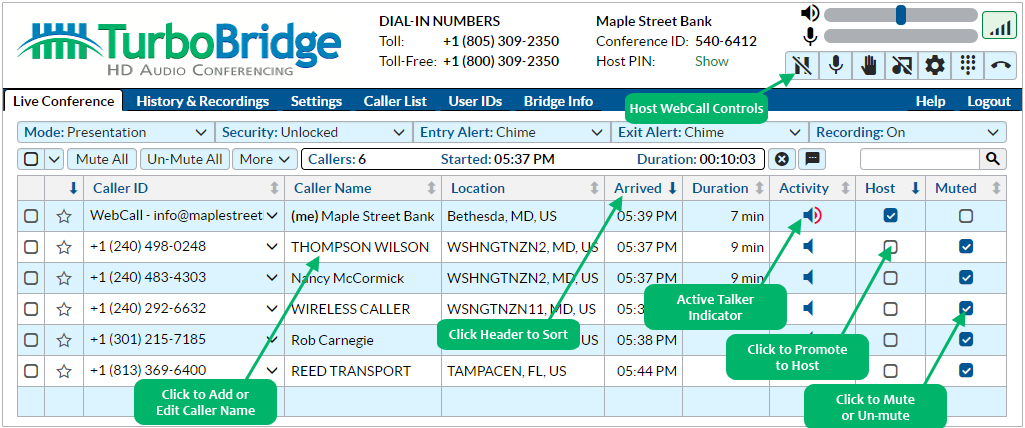
Modifying Active Conference Settings
All conference calls begin with the default feature settings, which can be modified via the Settings tab. The active settings are displayed in the top row. Clicking on a specific setting button triggers a drop-down selection box, allowing you to modify the setting for the active conference call.
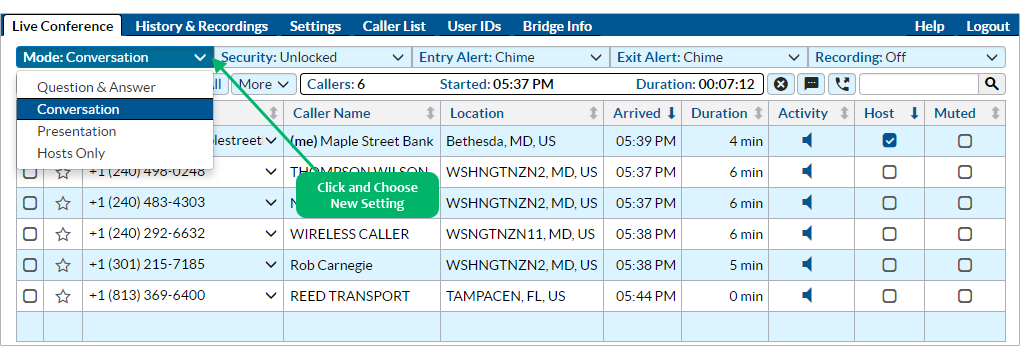
Caller Action Menu
There are multiple options for changing the active status of callers in the conference. For example, you can click on an empty box in the Host column to promote that caller to a Host, or click on a box in the Muted column to mute or un-mute a particular caller. The full set of caller-specific actions can be accessed by clicking on the number displayed in the Caller ID column. A drop down menu will be displayed, as shown below. Click on one of the menu options to instantly change the caller status.
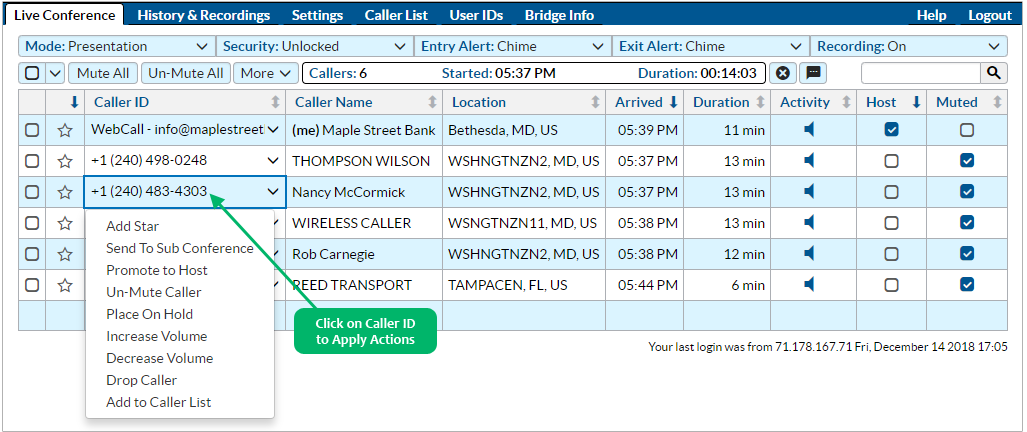
The options are described below:
- Add Star (Remove Star) – Same as clicking on a blank star icon in the second column.
- Send to Sub Conference Move caller to a sub conference. (Learn more at Using Breakout Rooms.)
- Promote to Host – Same as clicking on a blank box in the Host column.
- Mute Caller (Un-mute Caller) – Same as clicking on the box in the Muted column.
- Place on Hold (Take off Hold) – Temporarily removes the caller from the live conference, placing that caller on hold. A caller on hold cannot hear the conversation among the active callers in the live conference.
- Increase Volume – Increases the caller's speaking volume. You can repeat the action to further raise the volume. (This is comparable to that caller pressing the *86 Keypad Command.)
- Decrease Volume – Decreases the caller's speaking volume. You can repeat the action to further reduce the volume. (This is comparable to that caller pressing the *87 Keypad Command.)
- Drop Caller – Removes the caller from the conference call by terminating the caller's phone connection. If you select this option, you will get a pop-up box to confirm this action prior to the caller removal.
- Add to Caller List – Adds this caller to the stored list accessible via the Caller List tab.
Assign Caller Name
If the caller was not previously added to the Caller List, the Caller Name column displays the name information provided by the caller's phone company. Some mobile providers do not provide a name (the field may show “WIRELESS CALLER”), and name information is generally not available for callers outside the USA. Often, the caller name is displayed with the last name first (e.g., “SMITH SALLY”). You may assign or edit the name, which is stored in the Caller List. Stored names are linked to the Caller ID number. Note that many callers might share the same Caller ID if they are calling from an office location, or they are using services like Skype, so be careful assigning names in that situation. If the Caller ID is included in the Caller List, the Name column will display the stored name.
You can specify an extension in the Ext box, which is only used for Dial-Out Access. You may also use the Caller List entry to block the caller from joining future conference calls, by checking the Block checkbox. (This doesn't prevent them from joining from a different phone.) Blocked callers will hear an announcement that “the Conference ID you entered is temporarily unavailable.”
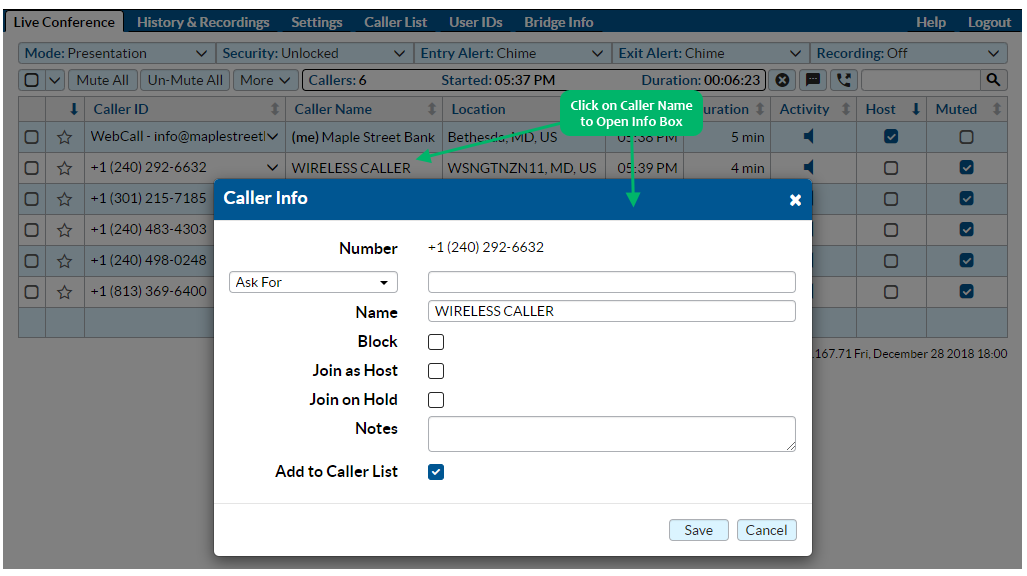
Simultaneously Apply Actions to Multiple Callers
You can use the first column to select multiple callers and simultaneously apply an action to the selected participants. For example, you can select some of the participants and temporarily place them on hold, while the remaining participants engage in a private conversation. Click on one or more of the checkboxes in the left column, then click on the More button to choose the action to apply to the selected callers. In the example below, the host first checks the boxes associated with two of the callers, and will then click on the More button.

Clicking on the More button brings up the list of possible actions to apply to the selected callers:

After applying the Place On Hold action, the Activity column indicates that the two callers are now on hold, and unable to hear those remaining in the conference.

Using the Star Column
You can “flag” a participant by clicking the corresponding star icon in the second column. This allows you to keep track of certain callers during a conference, which could be important guests. If you sort the callers by that column, the starred participants will persistently be listed at the top of the caller list display, so you can monitor when that caller is speaking or leaves the conference.

After clicking on star column header, the starred participants move to the top of the caller list, as shown below.

Filtering the Caller Display
You can place a value in the Filter box near the top right corner of the Live Conference display, which will remove all callers from the display which do not match the filter criteria. You can match any portion of the Caller ID (e.g., callers in a certain area code), Caller Name, or Location (e.g., callers from a certain city). The filter does not affect the status of the callers in the conference, but allows you to quickly find particular callers when you have many participants in the conference.

Managing a Question & Answer Session with the “Raise Your Hand” Feature
In conjunction with the *5 Raise Your Hand keypad command, you can use the Host Control Panel to fully manage a question and answer session during a large conference call, allowing you to un-mute callers one at a time to ask their questions in an orderly manner. For a complete description, see Managing a Question & Answer Session.
Other Actions Using the Live Conference Panel
Three icon buttons are displayed above the participant table:
 End Conference – This disconnects all participants and immediately terminates the conference. You will be prompted to confirm the action if you click on this button.
End Conference – This disconnects all participants and immediately terminates the conference. You will be prompted to confirm the action if you click on this button. Add Reference Label – You can specify any alphanumeric label associated with the active conference call. This label is contained in email post-conference report, the conference listing in the History & Recordings tab, and downloadable conference records. It could be a description or purpose of the call, project code, etc. This label can be subsequently edited via the History & Recordings tab.
Add Reference Label – You can specify any alphanumeric label associated with the active conference call. This label is contained in email post-conference report, the conference listing in the History & Recordings tab, and downloadable conference records. It could be a description or purpose of the call, project code, etc. This label can be subsequently edited via the History & Recordings tab. Dial-Out to Participant – If enabled on your account, this icon will be displayed. Clicking on this icon will prompt you to enter the phone number of the invited participant. For more information, see Dial-Out Access.
Dial-Out to Participant – If enabled on your account, this icon will be displayed. Clicking on this icon will prompt you to enter the phone number of the invited participant. For more information, see Dial-Out Access.

History & Recordings
The History & Recordings tab allows you to view past activity on your conference line and download details and recordings. You can view activity for a particular date range by selecting the dates and clicking the Show button. Click on the checkbox labeled Recorded conferences only to hide the listings for conferences that were not recorded. Click on the Download CSV button to download a list of conferences into a spreadsheet file.
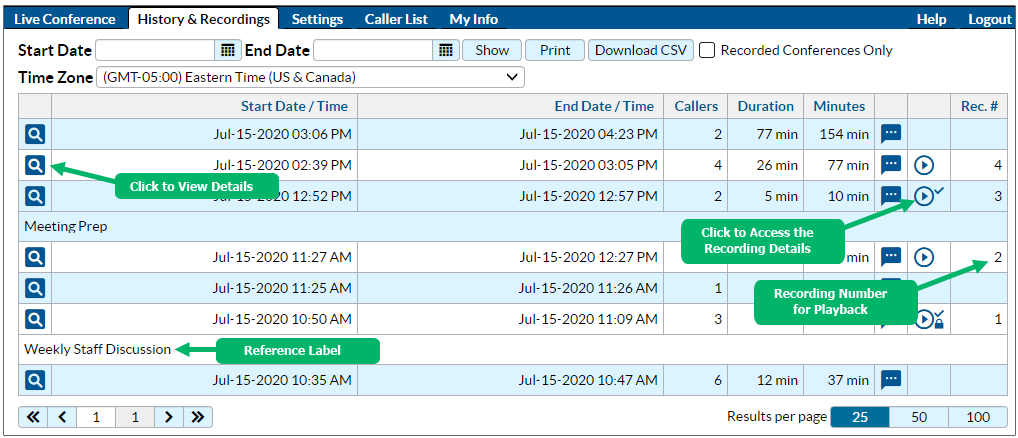
If a recording of the conference call is available, a ![]() play icon will be displayed in the right column. Click on that icon will bring up the Recording Menu. From that menu, you may click on the play button to listen to the recording through your web browser, download the .mp3 audio file to your computer, copy a download link (URL) to your clipboard that you could paste into an email, modify the dial-in Playback Options, or delete the recording. For playback instructions, see Recording Playback.
play icon will be displayed in the right column. Click on that icon will bring up the Recording Menu. From that menu, you may click on the play button to listen to the recording through your web browser, download the .mp3 audio file to your computer, copy a download link (URL) to your clipboard that you could paste into an email, modify the dial-in Playback Options, or delete the recording. For playback instructions, see Recording Playback.

Click on the  spyglass icon to view the details for a particular conference, as shown below. You can click on the Caller Name to add or edit the name stored in the Caller List. While this does not change the Caller Name for past conferences (including the name displayed on this page), this will assign the new Caller Name to the associated Caller ID phone number, so that the new Caller Name will be assigned to future calls from this phone number.
spyglass icon to view the details for a particular conference, as shown below. You can click on the Caller Name to add or edit the name stored in the Caller List. While this does not change the Caller Name for past conferences (including the name displayed on this page), this will assign the new Caller Name to the associated Caller ID phone number, so that the new Caller Name will be assigned to future calls from this phone number.
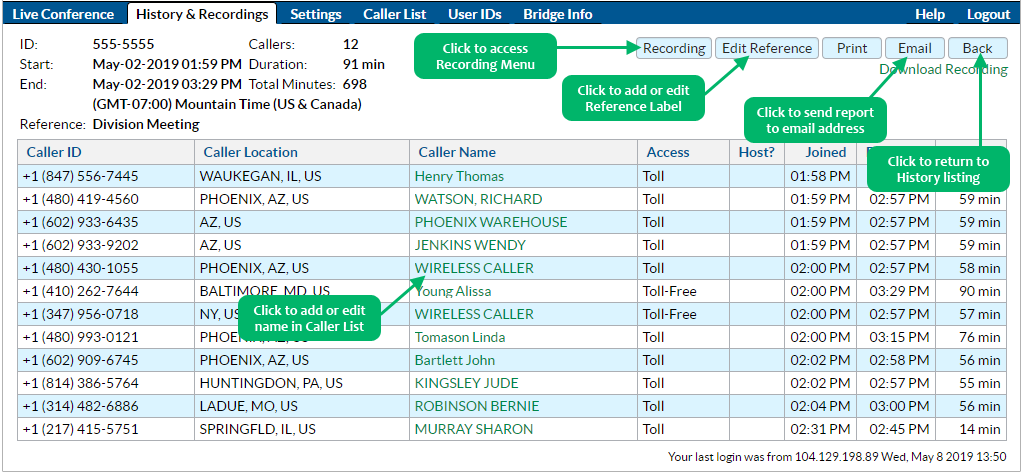
Settings
The Settings tab allows you to view the default feature settings for your conference line. All conferences begin with the default settings, though you can modify some of the settings during a live conference using a Host Keypad Command or the Live Conference Panel. Setting changes made during a live conference call do not modify the default settings. Additional information for some features may be viewed by clicking the corresponding  button. For a complete description of the settings and options, see Default Feature Settings.
button. For a complete description of the settings and options, see Default Feature Settings.
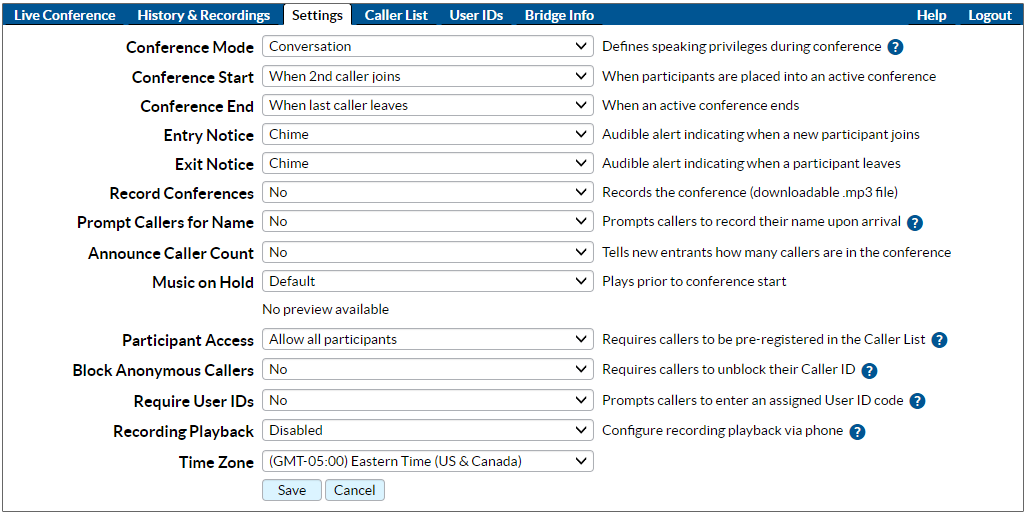
Caller List
In addition to editing caller information for entries that were saved to the Caller List through the Live Conference panel, you can add caller entries in advance of your conference calls via this tab. You can also initiate an immediate dial-out call to a listed participant, which will place them directly into your conference bridge if they accept the invitation. See Dial-Out Access for more information.

User IDs
You can add, edit and delete User IDs via this tab. See About User IDs for more information on this feature.

Bridge Info
General information regarding your service is displayed in the Bridge Info tab. (A “bridge” is the technical term for your conference room, which is uniquely identified by your Conference ID.) The three buttons at the bottom perform the following actions:
- Email My Info – Opens a pop-up box allowing you to specify an email address, which will receive an email listing the Conference ID, Host PIN, dial-in numbers, and usage instructions. Do not use this feature to notify participants of an upcoming conference, since it contains information that would allow the recipient to access your Host Control Panel to view activity and modify settings.
- Print Wallet Cards – Displays a printable sheet with a foldable wallet-size card containing your bridge information and Host Keypad Commands that you can print and cut out.
- Invite Text – Displays an editable form pre-loaded with the dial-in number and Conference ID. You can edit the form and copy & paste the text into an email to send to your invitees.
